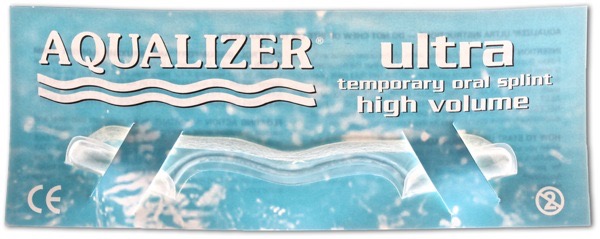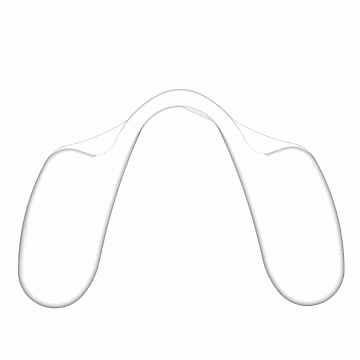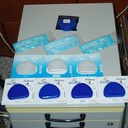
Aqualizer ultra
The classic Aqualizer® is no longer alone. Just like one shoe does not fit every foot for every purpose, there is no single bite cushion that can do everything best. The Aqualizer has a soft bite-feel since its casing is made by welding thin foil layers together. It is available in two sizes: The size „mini" places the water-filled cushion between the premolars and is mostly suitable for deciduous or shortened dental arches. The bite cushions of the regular size („ultra“) extend a few Millimeters further back and provide support as far back as to the first molars. Each version is available with three different fill-volumes, low, medium and high. Recently a narrow shape („slim“) became available as well, in order to address one of the problems of foil-welded devices: Sharp edges may irritate sensitive mucous membranes. Another problem is that the Aqualizer® casing allows water vapor to escape. After a number of days it may no longer provide the needed support, making a replacement necessary.
AquaSplint mini
The design of the AquaSplint® was mostly guided by the intention to provide a more positive position in the dental arch. The new AquaSplint® mini accomplishes this with an inserted wire which can be bent, giving the device a shape more closely conforming to that of the lower dental arch, regardless of its shape. The casing is not made by welding foils together, but by blowforming, similar to how bottles are manufactured. Inherently there are no sharp edges and the AquaSplint® does not lose its water filling over time. As a one-size-fits-all-device it is made a little shorter, rather than get in the way by sticking over the end of small dental arches. It has a size very similar to that of the Aqualizer® mini.

FreeBite CCD
To support the bite as far back as possible and thereby unload the TMJ best is the intention of the new FreeBite. This cannot be done with a device that is in a fixed position unless one would produce it in many sizes. The FreeBite follows therefore a different concept by laying loosely between the teeth, actually encouraging movement and play. The user can slide it to that position where it supports the posterior teeth best, while the front teeth do not contact it. At this time there are two basic shapes, CMD and CCD, the latter being higher and containing a more pronounced wedge-shape. Rather than wearing it for many hours at a time, the FreeBite mainly has been designed to produce a therapeutic effect in as short a time as possible. A relaxation in the bite may be observed after as little as 5 minutes chewing lightly on the FreeBite, similar to a bilateral chewing gum. In addition, there is a choice of filling, either with water (FreeBite balance) or air, which in contrast to water is compressible.
In order to pinpoint the best bite-cushion for the intended use, MediPlus offers Comparison Sets at a reduced price, allowing the user to test different bite cushions side-by-side, identifying one or the other as more effective, or even a combined use of more than one.
The mechanical properties of these devices have hardly been studied in a controlled environment, since the different manufacturers naturally are bent on sales, rather than researching properties which might make a competing product preferable in certain conditions. We want to correct this omission and start with a controlled study of the effective height in the mouth.
The effective height of the Aqualizer, AquaSplint and FreeBite
If you run into statements such as that teeth, tooth position and the bite have little or nothing to do with TMJ dysfunction, they usually represent a certain helplessness. Gnathologic techniques are in use since the 1940s where the dentist pushes the patient’s mandible out of the naturally developed alignment in the bite, in search of an axis of vertical movement called „hinge axis“. …
